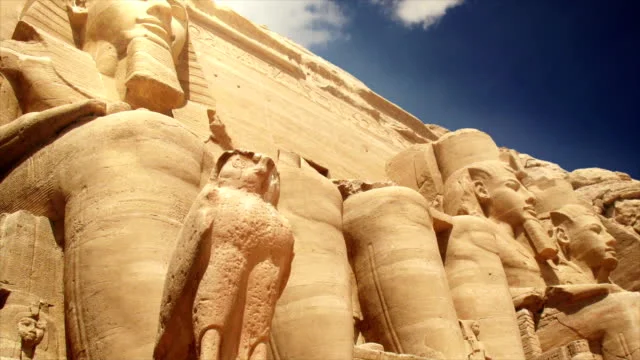Exploring the Marvels of Abu Simbel: A Journey Through Ancient Egypt
Nestled on the banks of Lake Nasser in southern Egypt, Abu Simbel is a remarkable archaeological site that offers visitors a glimpse into the grandeur and glory of ancient Egyptian civilization. With its awe-inspiring temples, fascinating history, and stunning surroundings, Abu Simbel is a destination that should be on every traveler's bucket list. In this article, we'll delve into what to do in Abu Simbel, what you'll see there, when to go, and how to reach this remote but captivating location from Luxor, Aswan, and Abu Simbel.
What to Do in Abu Simbel:
1. Visit the Temples of Abu Simbel:
The highlight of any trip to Abu Simbel is the grand temple of Ramses II and the smaller temples of Hathor and Nefertari. These colossal structures were carved into the rock cliffs during the reign of Pharaoh Ramses II in the 13th century BC. The main temple is adorned with massive statues of the pharaoh, while the smaller temple is dedicated to his beloved queen, Nefertari.
2. Witness the Sun Festival:
Abu Simbel is famous for its biannual Sun Festival, which occurs on February 22nd and October 22nd each year. During these special days, the sun's rays align perfectly to illuminate the inner sanctum of the temple, illuminating the statues of Ramses II and the gods. It's a breathtaking spectacle that attracts visitors from around the world.
3. Explore the Nubian Museum:
Located near the temples, the Nubian Museum is a treasure trove of artifacts and information about the Nubian culture and the relocation of the temples to their current site in the 1960s.
4. Enjoy Lake Nasser:
If you have some extra time, take a boat trip on Lake Nasser, where you can relax and enjoy the serene waters, abundant birdlife, and picturesque sunsets.
What You Will See There:
Abu Simbel is a unique historical site filled with architectural marvels and historical significance. Here's a closer look at the key attractions you'll encounter:
1. Temple of Ramses II:
The grand temple is fronted by four colossal statues of Ramses II seated on his throne. The interior features intricate carvings, chambers, and an awe-inspiring sanctuary.
2. Temple of Hathor and Nefertari:
The smaller temple is dedicated to Queen Nefertari and the goddess Hathor. Its façade is adorned with statues of the queen and the deity, making it a fascinating contrast to the grandeur of the main temple.
3. Inner Chambers:
Both temples house beautifully decorated chambers and halls with detailed reliefs that depict various aspects of Egyptian life and religion.
4. Nubian Museum:
The museum provides insights into the history of the Nubian people and the incredible engineering feat of relocating the temples.
5. Sun Festival:
If you visit during the Sun Festival, you'll witness the remarkable phenomenon where the sun's rays penetrate the temple and illuminate the inner sanctum.
When to Go:
The best time to visit Abu Simbel largely depends on your preferences and interests. However, here are some considerations:
Sun Festival: If you want to witness the Sun Festival, plan your visit for February 22nd or October 22nd. Be sure to arrive early to secure a good viewing spot, as this is a popular event.
Weather: The peak tourist season in Abu Simbel runs from November to February, when the weather is milder, making it a pleasant time to explore the area. However, it can get quite crowded during this period.
Avoiding Crowds: If you prefer a quieter experience, consider visiting during the shoulder seasons of March to May or September to October. These months offer pleasant weather and fewer tourists.
Summer: Abu Simbel can be scorching hot in the summer months, from June to August. If you can tolerate the heat, you may find fewer tourists during this time.
How to Get to Abu Simbel:
Abu Simbel is not as easily accessible as some of the more popular Egyptian destinations, but with some planning, you can get there from Luxor, Aswan, and even within Abu Simbel.
From Luxor:
The most common way to get to Abu Simbel from Luxor is by air. Several airlines operate daily flights between Luxor and Abu Simbel. The flight duration is approximately 1.5 hours.
From Aswan:
If you're starting from Aswan, you can also take a flight to Abu Simbel, which is a shorter 40-minute journey.
Within Abu Simbel:
Once you've arrived in Abu Simbel, getting around is relatively easy. The temples are within walking distance of the town, and you can explore the area on foot. There are also taxis available for short trips.
Abu Simbel is a remarkable destination that transports you back in time to the era of the Pharaohs. With its ancient temples, cultural significance, and awe-inspiring Sun Festival, it's a place that will leave a lasting impression. Whether you're a history enthusiast, an adventure seeker, or a curious traveler, a visit to Abu Simbel is an experience you won't soon forget. Plan your journey, and let the wonders of this ancient site captivate your senses.

